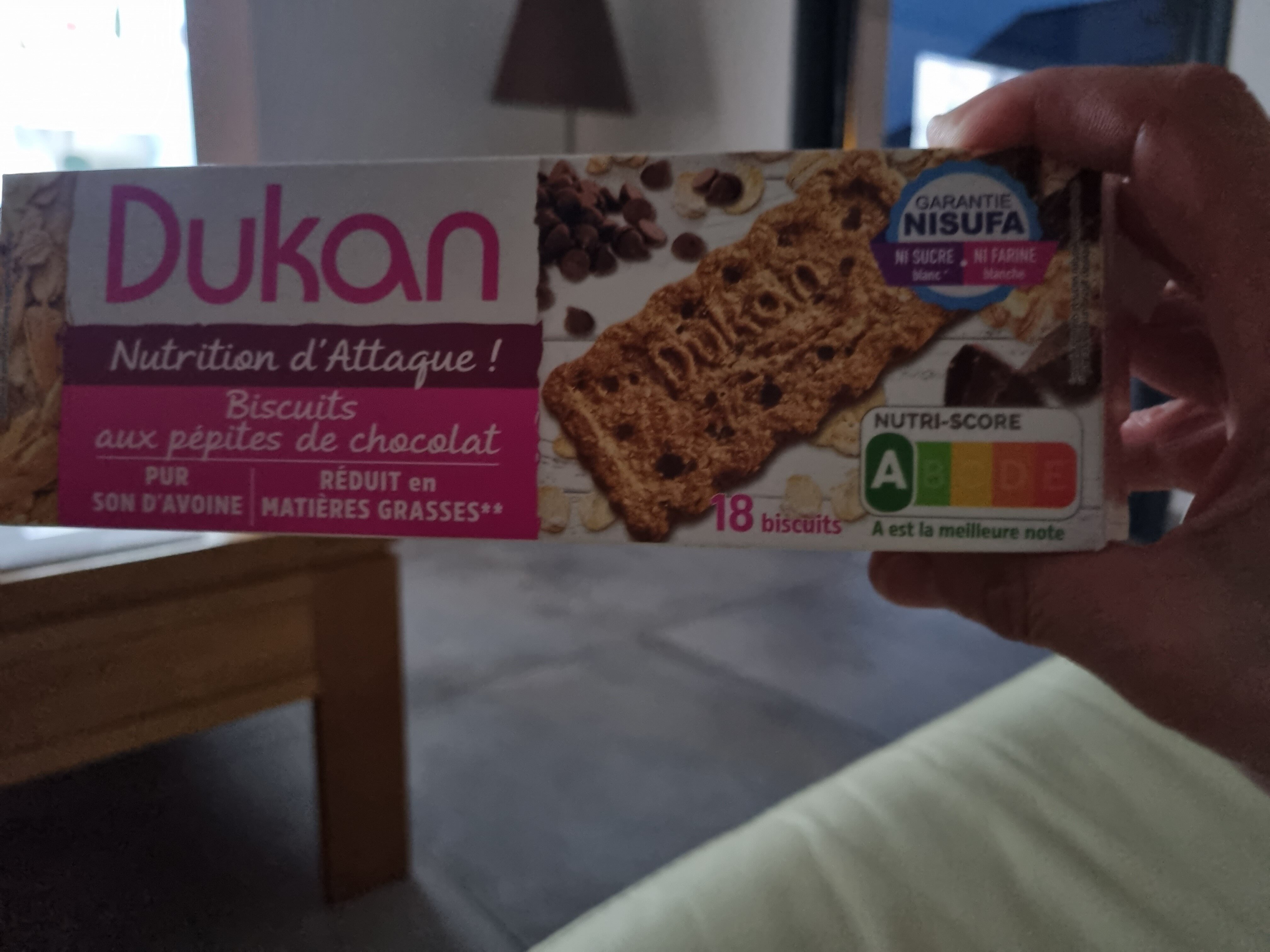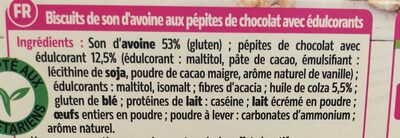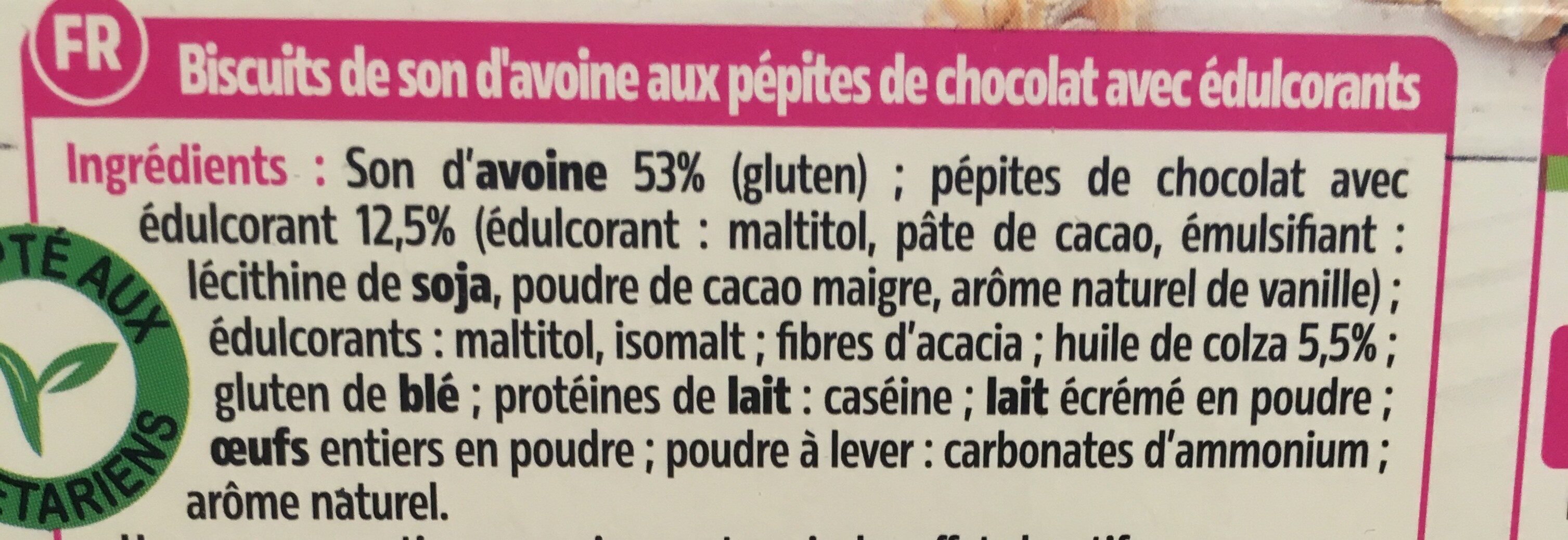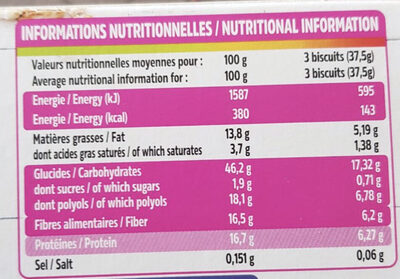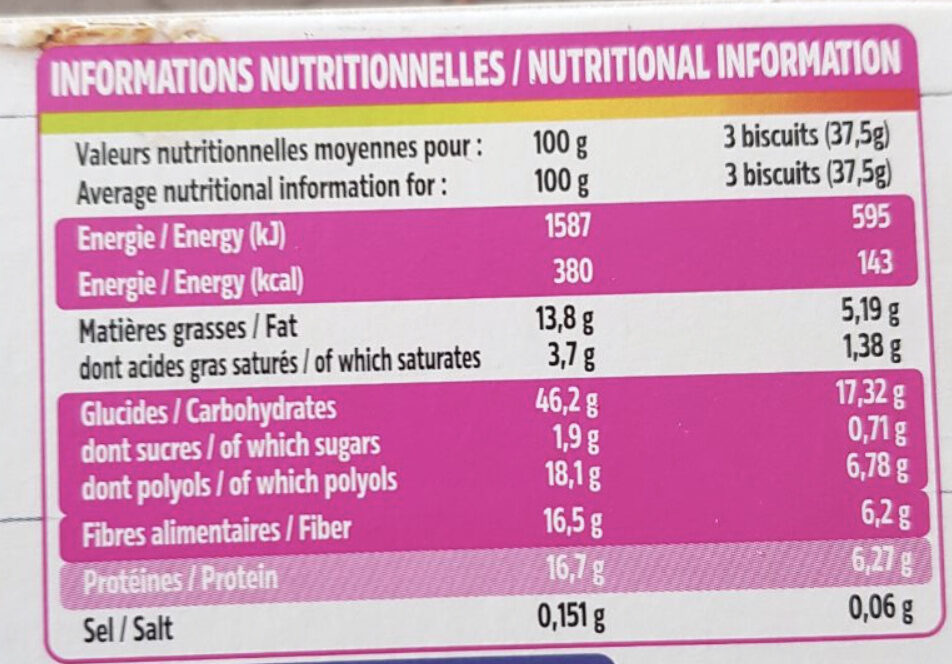Help us make food transparency the norm!
As a non-profit organization, we depend on your donations to continue informing consumers around the world about what they eat.
The food revolution starts with you!
Biscuits aux pépites de chocolat - Dukan - 225 g
Biscuits aux pépites de chocolat - Dukan - 225 g
This product page is not complete. You can help to complete it by editing it and adding more data from the photos we have, or by taking more photos using the app for Android or iPhone/iPad. Thank you!
×
Barra-kodea: 3760151011429 (EAN / EAN-13)
Izen arrunta: Biscuits de son d'avoine (65%) aux pépites de chocolat (12,5%) avec édulcorants
Kopurua: 225 g
Ontziratzea: en:Plastic, en:Cardboard
Markak: Dukan
Kategoriak: en:Snacks, en:Sweet snacks, en:Biscuits and cakes, Gaileta, en:Chocolate biscuits, en:Oatmeal cookies, fr:Biscuits édulcorés
Etiketak, ziurtagiriak, sariak:
en:Low or no sugar, Source of fibre, en:Green Dot, High fibres, No added sugar, Nutriscore, Nutriscore A, en:Avec édulcorants, en:Réduit en matières grasses, en:Sans farine blanche
Dendak: carrefour.fr
Matching with your preferences
Health
Osagaiak
-
23 ingredients
: Son d'avoine 53% (gluten) ; pépites de chocolat avec édulcorant 12,5% (édulcorant : maltitol, pâte de cacao, émulsifiant: lécithine de soja, poudre de cacao maigre, arôme naturel de vanille); édulcorants:maltitol, isomalt ; fibres d'acacia ; huile de colza 5,5% ; gluten de blé; protéines de lait: caséine; lait écrémé en poudre; ufs entiers en poudre; poudre à lever: carbonates d'ammonium; arôme naturel. ARIENS FR AUXAlergenoak: en:Eggs, en:Gluten, en:Milk, en:SoybeansAztarnak: en:en-nuts-en-sesame-seeds-fr-farine-blanche
Food processing
-
Ultra processed foods
Elements that indicate the product is in the 4 - Ultra prozesatutako elikagaiak eta edariak group:
- Gehigarria: E322
- Gehigarria: E953
- Gehigarria: E965
- Osagaia: Kaseina
- Osagaia: Emulsifier
- Osagaia: Flavouring
- Osagaia: Gluten
- Osagaia: Milk proteins
- Osagaia: Sweetener
Food products are classified into 4 groups according to their degree of processing:
- Prozesatu gabeko edo ahalik eta gutxien prozesatutako elikagaiak
- Sukaldaritzako osagaiak prozesatu
- Prozesatutako jakiak
- Ultra processed foods
The determination of the group is based on the category of the product and on the ingredients it contains.
Gehigarriak
-
E322
Lecithin: Lecithin -UK: , US: , from the Greek lekithos, "egg yolk"- is a generic term to designate any group of yellow-brownish fatty substances occurring in animal and plant tissues, which are amphiphilic – they attract both water and fatty substances -and so are both hydrophilic and lipophilic-, and are used for smoothing food textures, dissolving powders -emulsifying-, homogenizing liquid mixtures, and repelling sticking materials.Lecithins are mixtures of glycerophospholipids including phosphatidylcholine, phosphatidylethanolamine, phosphatidylinositol, phosphatidylserine, and phosphatidic acid.Lecithin was first isolated in 1845 by the French chemist and pharmacist Theodore Gobley. In 1850, he named the phosphatidylcholine lécithine. Gobley originally isolated lecithin from egg yolk—λέκιθος lekithos is "egg yolk" in Ancient Greek—and established the complete chemical formula of phosphatidylcholine in 1874; in between, he had demonstrated the presence of lecithin in a variety of biological matters, including venous blood, in human lungs, bile, human brain tissue, fish eggs, fish roe, and chicken and sheep brain. Lecithin can easily be extracted chemically using solvents such as hexane, ethanol, acetone, petroleum ether, benzene, etc., or extraction can be done mechanically. It is usually available from sources such as soybeans, eggs, milk, marine sources, rapeseed, cottonseed, and sunflower. It has low solubility in water, but is an excellent emulsifier. In aqueous solution, its phospholipids can form either liposomes, bilayer sheets, micelles, or lamellar structures, depending on hydration and temperature. This results in a type of surfactant that usually is classified as amphipathic. Lecithin is sold as a food additive and dietary supplement. In cooking, it is sometimes used as an emulsifier and to prevent sticking, for example in nonstick cooking spray.Source: Wikipedia (Ingeles)
-
E322i - Lezitina
Lecithin: Lecithin -UK: , US: , from the Greek lekithos, "egg yolk"- is a generic term to designate any group of yellow-brownish fatty substances occurring in animal and plant tissues, which are amphiphilic – they attract both water and fatty substances -and so are both hydrophilic and lipophilic-, and are used for smoothing food textures, dissolving powders -emulsifying-, homogenizing liquid mixtures, and repelling sticking materials.Lecithins are mixtures of glycerophospholipids including phosphatidylcholine, phosphatidylethanolamine, phosphatidylinositol, phosphatidylserine, and phosphatidic acid.Lecithin was first isolated in 1845 by the French chemist and pharmacist Theodore Gobley. In 1850, he named the phosphatidylcholine lécithine. Gobley originally isolated lecithin from egg yolk—λέκιθος lekithos is "egg yolk" in Ancient Greek—and established the complete chemical formula of phosphatidylcholine in 1874; in between, he had demonstrated the presence of lecithin in a variety of biological matters, including venous blood, in human lungs, bile, human brain tissue, fish eggs, fish roe, and chicken and sheep brain. Lecithin can easily be extracted chemically using solvents such as hexane, ethanol, acetone, petroleum ether, benzene, etc., or extraction can be done mechanically. It is usually available from sources such as soybeans, eggs, milk, marine sources, rapeseed, cottonseed, and sunflower. It has low solubility in water, but is an excellent emulsifier. In aqueous solution, its phospholipids can form either liposomes, bilayer sheets, micelles, or lamellar structures, depending on hydration and temperature. This results in a type of surfactant that usually is classified as amphipathic. Lecithin is sold as a food additive and dietary supplement. In cooking, it is sometimes used as an emulsifier and to prevent sticking, for example in nonstick cooking spray.Source: Wikipedia (Ingeles)
-
E503
Ammonium carbonate: Ammonium carbonate is a salt with the chemical formula -NH4-2CO3. Since it readily degrades to gaseous ammonia and carbon dioxide upon heating, it is used as a leavening agent and also as smelling salt. It is also known as baker's ammonia and was a predecessor to the more modern leavening agents baking soda and baking powder. It is a component of what was formerly known as sal volatile and salt of hartshorn.Source: Wikipedia (Ingeles)
-
E953
Isomalt: Isomalt is a sugar substitute, a type of sugar alcohol used primarily for its sugar-like physical properties. It has little to no impact on blood sugar levels, and does not stimulate the release of insulin. It also does not promote tooth decay, i.e. is tooth-friendly. Its energy value is 2 kcal/g, half that of sugars. However, like most sugar alcohols, it carries a risk of gastric distress, including flatulence and diarrhea, when consumed in large quantities -above about 20-30 g per day-. Isomalt may prove upsetting to the intestinal tract because it is incompletely absorbed in the small intestine, and when polyols pass into the large intestine, they can cause osmotically induced diarrhea and stimulate the gut flora, causing flatulence. As with other dietary fibers, regular consumption of isomalt can lead to desensitisation, decreasing the risk of intestinal upset. Isomalt can be blended with high-intensity sweeteners such as sucralose, giving a mixture that has the same sweetness as sugar. Isomalt is an equimolar mixture of two mutually diastereomeric disaccharides, each composed of two sugars: glucose and mannitol -α-D-glucopyranosido-1‚6-mannitol- and also glucose and sorbitol -α-D-glucopyranosido-1‚6-sorbitol-. Complete hydrolysis of isomalt yields glucose -50%-, sorbitol -25%-, and mannitol -25%-. It is an odorless, white, crystalline substance containing about 5% water of crystallisation. Isomalt has a minimal cooling effect -positive heat of solution-, lower than many other sugar alcohols, in particular, xylitol and erythritol. Isomalt is manufactured in a two-stage process in which sucrose is first transformed into isomaltulose, a reducing disaccharide -6-O-α-D-glucopyranosido-D-fructose-. The isomaltulose is then hydrogenated, using a Raney nickel catalyst. The final product — isomalt — is an equimolar composition of 6-O-α-D-glucopyranosido-D-sorbitol -1‚6-GPS- and 1-O-α-D-glucopyranosido-D-mannitol-dihydrate -1‚1-GPM-dihydrate-. Isomalt has been approved for use in the United States since 1990. It is also permitted for use in Australia, New Zealand, Canada, Mexico, Iran, the European Union, and other countries. Isomalt is widely used for the production of sugar-free candy, especially hard-boiled candy, because it resists crystallisation much better than the standard combinations of sucrose and corn syrup. It is used in sugar sculpture for the same reason.Source: Wikipedia (Ingeles)
-
E965
Maltitol: Maltitol is a sugar alcohol -a polyol- used as a sugar substitute. It has 75–90% of the sweetness of sucrose -table sugar- and nearly identical properties, except for browning. It is used to replace table sugar because it is half as caloric, does not promote tooth decay, and has a somewhat lesser effect on blood glucose. In chemical terms, maltitol is known as 4-O-α-glucopyranosyl-D-sorbitol. It is used in commercial products under trade names such as Lesys, Maltisweet and SweetPearl.Source: Wikipedia (Ingeles)
Ingredients analysis
-
en:Palm oil free
No ingredients containing palm oil detected
Unrecognized ingredients: fr:pepites-de-chocolat-avec-edulcorant, fr:ufs-entiers-en-poudre, fr:ariens-fr-auxSome ingredients could not be recognized.
We need your help!
You can help us recognize more ingredients and better analyze the list of ingredients for this product and others:
- Edit this product page to correct spelling mistakes in the ingredients list, and/or to remove ingredients in other languages and sentences that are not related to the ingredients.
- Add new entries, synonyms or translations to our multilingual lists of ingredients, ingredient processing methods, and labels.
If you would like to help, join the #ingredients channel on our Slack discussion space and/or learn about ingredients analysis on our wiki. Thank you!
-
en:Non-vegan
Non-vegan ingredients: en:Milk proteins, Kaseina, en:Skimmed milk powderSome ingredients could not be recognized.
We need your help!
You can help us recognize more ingredients and better analyze the list of ingredients for this product and others:
- Edit this product page to correct spelling mistakes in the ingredients list, and/or to remove ingredients in other languages and sentences that are not related to the ingredients.
- Add new entries, synonyms or translations to our multilingual lists of ingredients, ingredient processing methods, and labels.
If you would like to help, join the #ingredients channel on our Slack discussion space and/or learn about ingredients analysis on our wiki. Thank you!
-
en:Vegetarian status unknown
Unrecognized ingredients: fr:pepites-de-chocolat-avec-edulcorant, fr:ufs-entiers-en-poudre, fr:ariens-fr-auxSome ingredients could not be recognized.
We need your help!
You can help us recognize more ingredients and better analyze the list of ingredients for this product and others:
- Edit this product page to correct spelling mistakes in the ingredients list, and/or to remove ingredients in other languages and sentences that are not related to the ingredients.
- Add new entries, synonyms or translations to our multilingual lists of ingredients, ingredient processing methods, and labels.
If you would like to help, join the #ingredients channel on our Slack discussion space and/or learn about ingredients analysis on our wiki. Thank you!
-
Details of the analysis of the ingredients
We need your help!
Some ingredients could not be recognized.
We need your help!
You can help us recognize more ingredients and better analyze the list of ingredients for this product and others:
- Edit this product page to correct spelling mistakes in the ingredients list, and/or to remove ingredients in other languages and sentences that are not related to the ingredients.
- Add new entries, synonyms or translations to our multilingual lists of ingredients, ingredient processing methods, and labels.
If you would like to help, join the #ingredients channel on our Slack discussion space and/or learn about ingredients analysis on our wiki. Thank you!
: Son d'avoine 53%, pépites de chocolat avec édulcorant 12.5% (édulcorant (maltitol), pâte de cacao, émulsifiant (lécithine de soja), poudre de cacao maigre, arôme naturel de vanille), édulcorants (maltitol), isomalt, fibres d'acacia, huile de colza 5.5%, gluten de blé, protéines de lait (caséine), lait écrémé en poudre, ufs entiers en poudre, poudre à lever (carbonates d'ammonium), arôme naturel, ARIENS FR AUX- Son d'avoine -> en:oat-bran - vegan: yes - vegetarian: yes - ciqual_food_code: 9640 - percent_min: 53 - percent: 53 - percent_max: 53
- pépites de chocolat avec édulcorant -> fr:pepites-de-chocolat-avec-edulcorant - percent_min: 12.5 - percent: 12.5 - percent_max: 12.5
- édulcorant -> en:sweetener - percent_min: 2.5 - percent_max: 12.5
- maltitol -> en:e965 - vegan: yes - vegetarian: yes - percent_min: 2.5 - percent_max: 12.5
- pâte de cacao -> en:cocoa-paste - vegan: yes - vegetarian: yes - ciqual_proxy_food_code: 16030 - percent_min: 0 - percent_max: 6.25
- émulsifiant -> en:emulsifier - percent_min: 0 - percent_max: 4.16666666666667
- lécithine de soja -> en:soya-lecithin - vegan: yes - vegetarian: yes - ciqual_food_code: 42200 - percent_min: 0 - percent_max: 4.16666666666667
- poudre de cacao maigre -> en:fat-reduced-cocoa-powder - vegan: yes - vegetarian: yes - ciqual_food_code: 18100 - percent_min: 0 - percent_max: 3.125
- arôme naturel de vanille -> en:natural-vanilla-flavouring - vegan: yes - vegetarian: yes - percent_min: 0 - percent_max: 2.5
- édulcorant -> en:sweetener - percent_min: 2.5 - percent_max: 12.5
- édulcorants -> en:sweetener - percent_min: 5.5 - percent_max: 12.5
- maltitol -> en:e965 - vegan: yes - vegetarian: yes - percent_min: 5.5 - percent_max: 12.5
- isomalt -> en:e953 - vegan: yes - vegetarian: yes - percent_min: 5.5 - percent_max: 12.5
- fibres d'acacia -> en:acacia-fibre - vegan: yes - vegetarian: yes - percent_min: 5.5 - percent_max: 9.66666666666667
- huile de colza -> en:colza-oil - vegan: yes - vegetarian: yes - from_palm_oil: no - ciqual_food_code: 17130 - percent_min: 5.5 - percent: 5.5 - percent_max: 5.5
- gluten de blé -> en:wheat-gluten - vegan: yes - vegetarian: yes - percent_min: 0 - percent_max: 3.6
- protéines de lait -> en:milk-proteins - vegan: no - vegetarian: yes - percent_min: 0 - percent_max: 3
- caséine -> en:casein - vegan: no - vegetarian: yes - percent_min: 0 - percent_max: 3
- lait écrémé en poudre -> en:skimmed-milk-powder - vegan: no - vegetarian: yes - ciqual_food_code: 19054 - percent_min: 0 - percent_max: 2.57142857142857
- ufs entiers en poudre -> fr:ufs-entiers-en-poudre - percent_min: 0 - percent_max: 2.25
- poudre à lever -> en:raising-agent - percent_min: 0 - percent_max: 2
- carbonates d'ammonium -> en:e503 - vegan: yes - vegetarian: yes - percent_min: 0 - percent_max: 2
- arôme naturel -> en:natural-flavouring - vegan: maybe - vegetarian: maybe - percent_min: 0 - percent_max: 1.8
- ARIENS FR AUX -> fr:ariens-fr-aux - percent_min: 0 - percent_max: 1.63636363636364
Elikadura
-
Nutrizio-kalitate oso ona
⚠ ️Warning: the amount of fruits, vegetables and nuts is not specified on the label, it was estimated from the list of ingredients: 5This product is not considered a beverage for the calculation of the Nutri-Score.
Positive points: 10
- Proteinak: 5 / 5 (balioa: 16.7, rounded value: 16.7)
- Fiber: 5 / 5 (balioa: 14.4, rounded value: 14.4)
- Fruits, vegetables, nuts, and colza/walnut/olive oils: 0 / 5 (balioa: 5.5, rounded value: 5.5)
Negative points: 7
- Energia: 4 / 10 (balioa: 1590, rounded value: 1590)
- Azukreak: 0 / 10 (balioa: 1.9, rounded value: 1.9)
- Gantz saturatua: 3 / 10 (balioa: 3.7, rounded value: 3.7)
- Sodioa: 0 / 10 (balioa: 60, rounded value: 60)
The points for proteins are counted because the negative points are less than 11.
Nutritional score: (7 - 10)
Nutri-Score:
-
Nutrient levels
-
Koipe in moderate quantity (13.8%)
What you need to know- A high consumption of fat, especially saturated fats, can raise cholesterol, which increases the risk of heart diseases.
Recommendation: Limit the consumption of fat and saturated fat- Choose products with lower fat and saturated fat content.
-
Gantz-azido ase in moderate quantity (3.7%)
What you need to know- A high consumption of fat, especially saturated fats, can raise cholesterol, which increases the risk of heart diseases.
Recommendation: Limit the consumption of fat and saturated fat- Choose products with lower fat and saturated fat content.
-
Azukre in low quantity (1.9%)
What you need to know- A high consumption of sugar can cause weight gain and tooth decay. It also augments the risk of type 2 diabetes and cardio-vascular diseases.
Recommendation: Limit the consumption of sugar and sugary drinks- Sugary drinks (such as sodas, fruit beverages, and fruit juices and nectars) should be limited as much as possible (no more than 1 glass a day).
- Choose products with lower sugar content and reduce the consumption of products with added sugars.
-
Gatz arrunt in low quantity (0.15%)
What you need to know- A high consumption of salt (or sodium) can cause raised blood pressure, which can increase the risk of heart disease and stroke.
- Many people who have high blood pressure do not know it, as there are often no symptoms.
- Most people consume too much salt (on average 9 to 12 grams per day), around twice the recommended maximum level of intake.
Recommendation: Limit the consumption of salt and salted food- Reduce the quantity of salt used when cooking, and don't salt again at the table.
- Limit the consumption of salty snacks and choose products with lower salt content.
-
-
Nutrition facts
Nutrition facts As sold
for 100 g / 100 mlAs sold
per serving (37.5g)Compared to: en:Oatmeal cookies Energia 1.590 kj
(380 kcal)596 kj
(142 kcal)-% 16 Koipe 13,8 g 5,18 g -% 27 Gantz-azido ase 3,7 g 1,39 g -% 23 Carbohydrates 46,2 g 17,3 g -% 24 Azukre 1,9 g 0,713 g -% 90 Polyols 5 g 1,88 g Fiber 14,4 g 5,4 g +% 159 Proteina 16,7 g 6,26 g +% 127 Gatz arrunt 0,15 g 0,056 g -% 76 Fruits‚ vegetables‚ nuts and rapeseed‚ walnut and olive oils (estimate from ingredients list analysis) 5,5 % 5,5 % Beta-glucan 5,2 g 1,95 g
Ingurumena
-
Eco-Score C - Moderate environmental impact
The Eco-Score is an experimental score that summarizes the environmental impacts of food products.→ The Eco-Score was initially developped for France and it is being extended to other European countries. The Eco-Score formula is subject to change as it is regularly improved to make it more precise and better suited to each country.Life cycle analysis
-
Average impact of products of the same category: C (Score: 56/100)
Kategoria: Biscuit (cookie), with chocolate, prepacked
Kategoria: Biscuit (cookie), with chocolate, prepacked
- PEF environmental score: 0.47 (the lower the score, the lower the impact)
- including impact on climate change: 5.92 kg CO2 eq/kg of product
Stage Impact Agriculture
63.6 %Processing
29.8 %Ontziratzea
2.3 %Transportation
3.2 %Distribution
1.0 %Consumption
0.0 %
Bonuses and maluses
-
Missing origins of ingredients information
Malus: -5
⚠ ️ The origins of the ingredients of this product are not indicated.
If they are indicated on the packaging, you can modify the product sheet and add them.
If you are the manufacturer of this product, you can send us the information with our free platform for producers.
-
Packaging with a medium impact
Malus: -11
Shape Material Recycling Impact Unknown Plastic Altua Unknown Cardboard Baxua ⚠ ️ The information about the packaging of this product is not sufficiently precise (exact shapes and materials of all components of the packaging).⚠ ️ For a more precise calculation of the Eco-Score, you can modify the product page and add them.
If you are the manufacturer of this product, you can send us the information with our free platform for producers.
Eco-Score for this product
-
Impact for this product: C (Score: 40/100)
Produktua: Biscuits aux pépites de chocolat - Dukan - 225 g
Life cycle analysis score: 56
Sum of bonuses and maluses: -16
Final score: 40/100
-
Carbon footprint
-
Equal to driving 3.1 km in a petrol car
592 g CO² per 100g of product
The carbon emission figure comes from ADEME's Agribalyse database, for the category: Biscuit (cookie), with chocolate, prepacked (Source: ADEME Agribalyse Database)
Stage Impact Agriculture
52.9 %Processing
42.0 %Ontziratzea
1.9 %Transportation
2.9 %Distribution
0.3 %Consumption
0.0 %
Ontziratzea
-
Packaging with a medium impact
-
Packaging parts
(Plastic)
(Cardboard)
-
Bilgarriaren materialak
Material % Bilgarriaren pisua Bilgarriaren pisua produktuaren 100g-ko Paper or cardboard Plastic Guztira
-
Transportation
-
Origins of ingredients
Missing origins of ingredients information
⚠ ️ The origins of the ingredients of this product are not indicated.
If they are indicated on the packaging, you can modify the product sheet and add them.
If you are the manufacturer of this product, you can send us the information with our free platform for producers.Add the origins of ingredients for this product Add the origins of ingredients for this product
Report a problem
-
Incomplete or incorrect information?
Category, labels, ingredients, allergens, nutritional information, photos etc.
If the information does not match the information on the packaging, please complete or correct it. Open Food Facts is a collaborative database, and every contribution is useful for all.
Datuen iturria
Product added on by openfoodfacts-contributors
Last edit of product page on by smoothie-app.
Produktuaren orria -gatik editatua additives-app-chakib, clarallyy, desan, driveoff, ecoscore-impact-estimator, faneliack, gmlaa, jeanbono, jniderkorn, kiliweb, moon-rabbit, naruyoko, packbot, scanbot, sebleouf, tacite, val-20o4, yuka.R1lCZUl2MDlnL2tnaXNBMDJRL09wNDl4bW9LSGJXV3JMT1FCSVE9PQ, yuka.R3I0R0xib25vZkkydWZjUm9naUw5UEJsbm8reVptR25Lcm9lSWc9PQ, yuka.U0x0WUlhZ2xpZDlVbDhWajF4S0p3bzEyL3FTRVhsR2VCTll1SVE9PQ, yuka.UjZZL01QbzhuYUE2c050djhncU14Tll0ekx2eFlXcVBjT2t3SVE9PQ, yuka.WTRNY0ZZTlppZm9ha01jWHh4T0V3UEZlOVkyQ1lrcW5EZk1CSWc9PQ, yuka.WllZOEY3azV2L3c3bFBZMHBpdlY5b05hN0lTdGZYaVNkdGcvSVE9PQ, yuka.YTR3dkY0Y0QrT0VOdXR0aDMwek0vKzllbmFLWVEwSzFETm93SVE9PQ, yuka.YXF3T0sveGRwZVFCdHZZeTBpL05xL1J2MktTYmQxMnFDc3M0SUE9PQ, yuka.ZUo4QUdaOHh0L2t5cHYwWDJpM3FvUHRINDgvelhWNm1lK2xBSUE9PQ, yuka.ZjV3R0taNHVnS2NudGM5bC9rNzh4OTVweE1HSlltR3NNT2tkSVE9PQ, yuka.ZnJBSkQ3NGtxTmcxbnNFeHhncjQ0WXdsK3JDaUJueWxLK3RPSUE9PQ, yuka.sY2b0xO6T85zoF3NwEKvlkVEdOHxhBTtGQDUsEeT2uWsFbrGWO5suK7CPKs.
Last check of product page on by jniderkorn.

